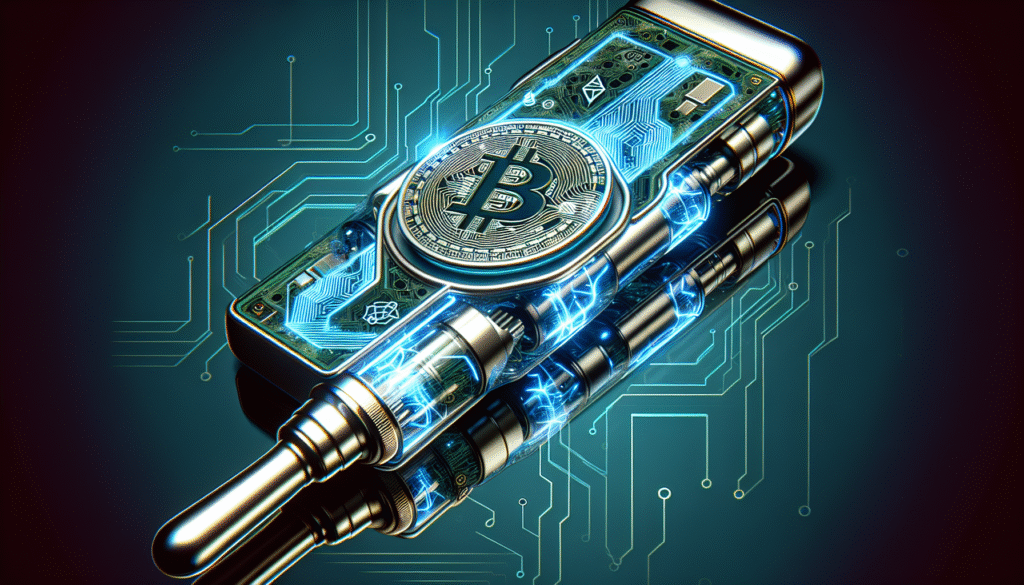Have you ever wondered how cryptocurrency can transform the world of medical device innovation? While it might seem that these two fields operate in vastly different spheres, their intersection could offer groundbreaking advancements. Crypto, the digital currency realm, may seem a world away from the tangible and technical domain of medical devices, yet combining them could create new pathways for innovation, development, and distribution. Let’s explore how you can harness the potential of crypto to revolutionize the medical device industry.

Understanding the Basics
Before diving into the intersection between crypto and medical devices, it’s essential to have a clear understanding of each domain. You might be well-versed in these topics or just starting; either way, a quick refresher can help set the stage for more complex discussions.
What is Cryptocurrency?
Cryptocurrency is a type of digital or virtual currency that uses cryptography for security. It’s decentralized and operates on a technology called blockchain, which is a distributed ledger enforced by a network of computers. The most popular cryptocurrencies include Bitcoin, Ethereum, and Litecoin, each offering different functionalities and applications.
Cryptocurrencies differ from traditional currencies primarily in their decentralization and potential for anonymity. You have the freedom to transact with anyone globally without the need for intermediaries like banks. This opens up incredible possibilities for innovation, especially in sectors like healthcare, where traditional systems can be cumbersome and slow.
The World of Medical Devices
Medical devices, on the other hand, are instruments or machines used to diagnose, prevent, monitor, and treat medical conditions. These devices range from simple tongue depressors to sophisticated MRI machines. Medical devices play a crucial role in modern medicine, continually evolving with technological advancements.
Innovation in this sector is particularly important as it directly impacts people’s health and quality of life. However, the development process is often lengthy and expensive due to strict regulatory requirements designed to ensure safety and effectiveness.
Why Fuse Crypto with Medical Devices?
Now you might ask, why should crypto have anything to do with medical devices? The answer lies in the unique benefits that cryptocurrencies and blockchain technology can bring to the table. These advantages can address several pain points in the healthcare industry, offering opportunities for improvement and innovation.
Enhanced Security and Privacy
With the advent of digital transformation in healthcare, data security and privacy have become paramount. Medical devices often gather sensitive patient information that needs to be protected. Blockchain technology, underpinning cryptocurrencies, provides a highly secure platform for data storage and sharing.
By using blockchain, you can ensure that medical data remains immutable and accessible only to authorized parties. This not only protects patient privacy but also ensures data integrity, which is crucial for accurate diagnostics and treatment.
Facilitating Funding and Investment
Financing is often a significant hurdle in developing new medical devices. Traditional funding routes can be cumbersome, slow, and exclusive. Cryptocurrencies open new avenues for funding through Initial Coin Offerings (ICOs) and other blockchain-based fundraising methods.
You can leverage these mechanisms to democratize investment opportunities, enabling more stakeholders to participate in the development and deployment of innovative medical technologies. This can accelerate the timeline from concept to market, benefiting both innovators and patients.
Enhancing Supply Chain Efficiency
Blockchain offers transparency and traceability, which are critical in the supply chain management of medical devices. With crypto technologies, you can track the journey of a device from the manufacturer to the end-user, ensuring authenticity and compliance with regulations.
This transparency reduces the risk of counterfeit devices entering the market, which is a significant concern in healthcare. It also ensures that devices are delivered safely and efficiently, thereby improving patient outcomes.
Encouraging Global Collaboration
Cryptocurrencies can facilitate global collaboration in medical research and innovation. By utilizing decentralized platforms, researchers, developers, and manufacturers worldwide can collaborate more effectively, sharing insights and resources without the barriers of geographical and financial constraints.
You can participate in collaborative initiatives that pool resources and expertise from various stakeholders, leading to more robust and innovative medical solutions.
Challenges and Considerations
While the potential advantages of integrating crypto with medical devices are significant, it’s also essential to consider the challenges and constraints you might encounter. Understanding these can help develop effective strategies to harness the benefits while mitigating risks.
Regulatory Hurdles
The medical device industry is heavily regulated to ensure safety and efficacy. Introducing cryptocurrency into this domain adds an extra layer of complexity. Regulatory bodies might be unfamiliar with crypto applications, potentially slowing down the adoption process.
It’s crucial to work closely with regulators to develop frameworks that accommodate these new technologies without compromising on safety standards. You may need to engage in ongoing dialogue with policymakers to facilitate a clearer understanding of crypto’s benefits and limitations.
Technology Adoption
The healthcare sector can be slow to adopt new technologies, especially those as disruptive as cryptocurrency. Integrating blockchain and crypto solutions requires significant changes to existing systems and processes.
You must ensure that stakeholders are adequately educated about the benefits of such integrations. This includes training and support to ease the transition and ensure that the technology is effectively utilized.
Security Concerns
While blockchain is inherently secure, the broader cryptocurrency ecosystem has been plagued with security breaches and scams. Protecting funds and data in this realm requires vigilant security measures and a proactive approach to potential threats.
Implementing robust security protocols and continually monitoring for vulnerabilities are essentials for safe operations within the crypto space. Ensuring comprehensive security can build trust with users and stakeholders.
Practical Applications and Case Studies
Understanding theoretical benefits and challenges is vital, but concrete examples can provide valuable insights into how these concepts are applied in real-world scenarios. Let’s look at some practical applications and case studies where crypto has already begun impacting the medical device industry.
Blockchain for Secure Health Records
Several projects are using blockchain technology to create secure, immutable health records that patients can access and control. By giving patients ownership of their medical data, they can share it with medical devices and healthcare providers securely and efficiently.
For instance, a pilot project in Estonia is using blockchain to securely digitalize medical records. This framework allows seamless integration with various medical devices, ensuring accurate and real-time data transfer while preserving patient privacy.
Tokenized Incentives for Medical Research
Another innovative application is using crypto tokens to incentivize participation in medical research and data sharing. Patients who contribute data through wearables and medical devices can earn tokens, which can be redeemed for health services or other benefits.
This model not only encourages wider participation in research but also provides more comprehensive datasets for medical device development. Companies like Nebula Genomics have explored such approaches to foster a more dynamic and patient-centric research environment.
Crypto-enabled Supply Chain Management
In pharmaceutical logistics, blockchain implementations have shown promise in tracking and verifying the supply chain from production to end-user delivery, minimizing the risk of counterfeit products. The same principles can apply to medical devices.
A pilot program by DHL in collaboration with Accenture illustrated the potential of blockchain to enhance transparency and accuracy in supply chain tracking. Such improvements can ensure that medical devices retain their integrity from the point of manufacture through to patient use.

The Future Landscape
Imagining the future of medical devices intertwined with cryptocurrency and blockchain technology opens up a world of possibilities. The pioneering days are still ahead, and your engagement in this intersection will shape the outcomes.
Accelerating Innovation Cycles
The use of crypto can significantly shorten the time it takes for new medical devices to move from concept to market. By unlocking decentralized funding and enabling global collaboration, the entire innovation cycle can be accelerated, delivering lifesaving technologies to patients faster.
Innovative financial models powered by cryptocurrencies may also lead to more personalized medical devices. By reducing barriers to entry and allowing more tailored investments, you can drive the development of devices that cater to specific patient needs and conditions.
Building a Resilient Ecosystem
A fusion of crypto and medical technology could contribute to a more resilient healthcare ecosystem. From enhancing patient outcomes through data integrity to safeguarding device authenticity in supply chains, this integration promises improvements across multiple facets of healthcare.
By adopting these technologies, you pave the way for a system where healthcare delivery is more efficient, equitable, and transparent. As you engage with these emerging trends, you contribute to building an ecosystem ready to meet the unique challenges of future healthcare demands.
Empowering Patients and Innovators
Empowerment is a recurring theme when discussing the impacts of crypto in the medical device realm. Patients gain control over their data and play an active role in research and treatment decisions. Innovators access new tools and funding opportunities to bring their visions to life.
Such empowerment can lead to a democratization of healthcare innovation, where diverse voices and ideas contribute to more inclusive and effective solutions. By embracing crypto, you support a future where medical device innovation is not just a privilege but a shared pursuit.
Concluding Thoughts
The intersection of cryptocurrency and medical device innovation presents a fertile ground for reimagining healthcare delivery. While challenges remain, the potential benefits offer compelling reasons to explore this integration further. As an innovator, investor, or healthcare professional, your engagement with this emerging field could unlock unprecedented possibilities for growth and improvement. By harnessing the power of crypto, you have the opportunity to pioneer transformative change in medical technology, shaping a future where healthcare is more accessible, transparent, and effective than ever before.

